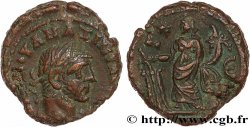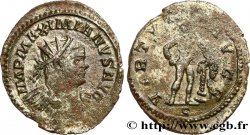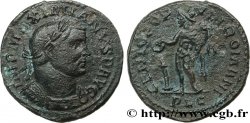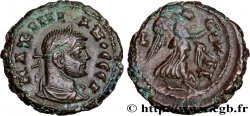E-auction 608-583566 - brm_602688 - MAXIMIANUS HERCULIUS Aurelianus
You must signin and be an approved bidder to bid, LOGIN TO BID. Accounts are subject to approval and the approval process takes place within 48 hours. Do not wait until the day a sale closes to register. Clicking on « bid » constitutes acceptance of the terms of use of cgb.fr private e-auctions.
Bids must be placed in whole Euro amounts only. The sale will start closing at the time stated on the item description; any bids received at the site after the closing time will not be executed. Transmission times may vary and bids could be rejected if you wait until the last second. For further information ckeck the E-auctions F.A.Q.
NO BUYER'S FEE.
NO BUYER'S FEE.
| Estimate : | 110 € |
| Price : | 26 € |
| Maximum bid : | 42 € |
| End of the sale : | 09 December 2024 14:10:40 |
| bidders : | 7 bidders |
Type : Aurelianus
Date: printemps 290-291
Date: 290-291
Mint name / Town : Lyon
Metal : billon
Millesimal fineness : 50 ‰
Diameter : 21 mm
Orientation dies : 7 h.
Weight : 3,81 g.
Officine: 2e
Coments on the condition:
Exemplaire de qualité exceptionnelle sur un petit flan bien centré des deux côtés avec les grènetis visibles. Beau buste de Maximien Hercule. Revers de haut relief, bien venu à la frappe. Patine de médaillier gris métallique avec des reflets dorés. Conserve la plus grande partie de son brillant de frappe et de son coupant d’origine
Catalogue references :
Obverse
Obverse legend : IMP MAXIMIANVS AVG.
Obverse description : Buste radié et cuirassé de Maximien Hercule à droite drapé sur l’épaule, vu de trois quarts en avant (B).
Obverse translation : "Imperator Maximianus Augustus", (Empereur Maximien Auguste).
Reverse
Reverse legend : PAX - A-VGG/ -|-// B.
Reverse description : Pax (la Paix) debout à gauche, tenant un globe nicéphore de la main droite et un sceptre transversal de la main gauche.
Reverse translation : "Pax Augustorum", (La Paix des Augustes).
Commentary
Avec l’intégralité de son argenture superficielle. Rubans de type 3 aux estrémités bouletées. Cuirasse et épaulière cloutées. Ptéryges fines et tombantes.
With all of its surface silvering. Type 3 ribbons with balled ends. Studded breastplate and shoulder guard. Thin, drooping pteryga
With all of its surface silvering. Type 3 ribbons with balled ends. Studded breastplate and shoulder guard. Thin, drooping pteryga








 Report a mistake
Report a mistake Print the page
Print the page Share my selection
Share my selection Ask a question
Ask a question Consign / sell
Consign / sell
 Full data
Full data












